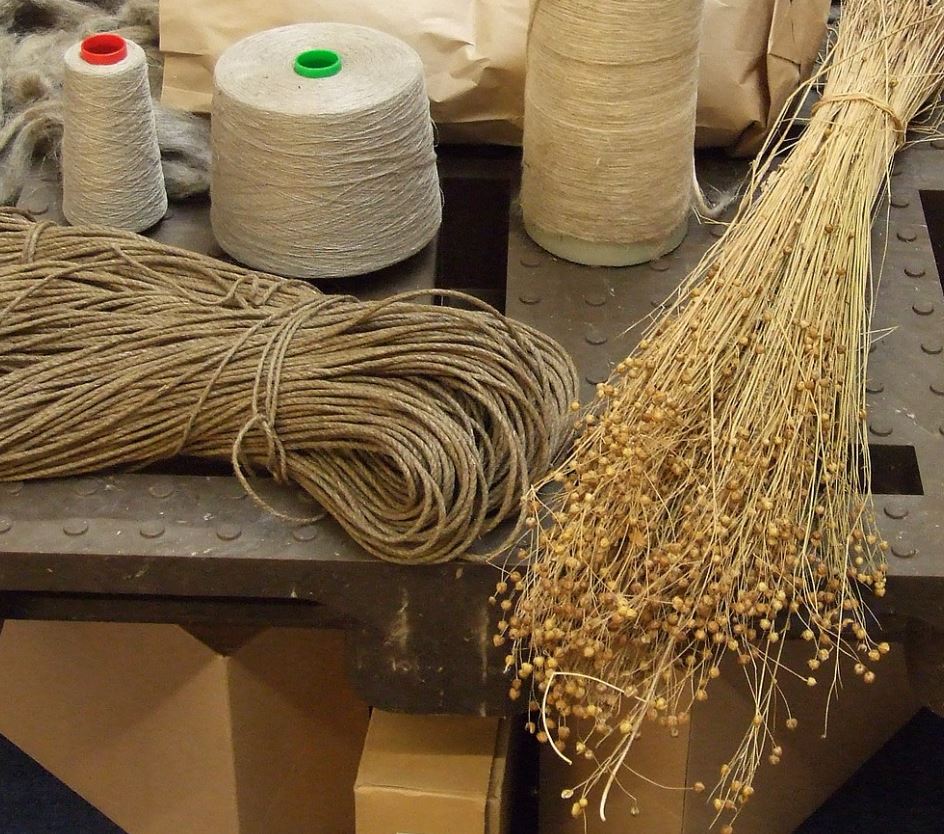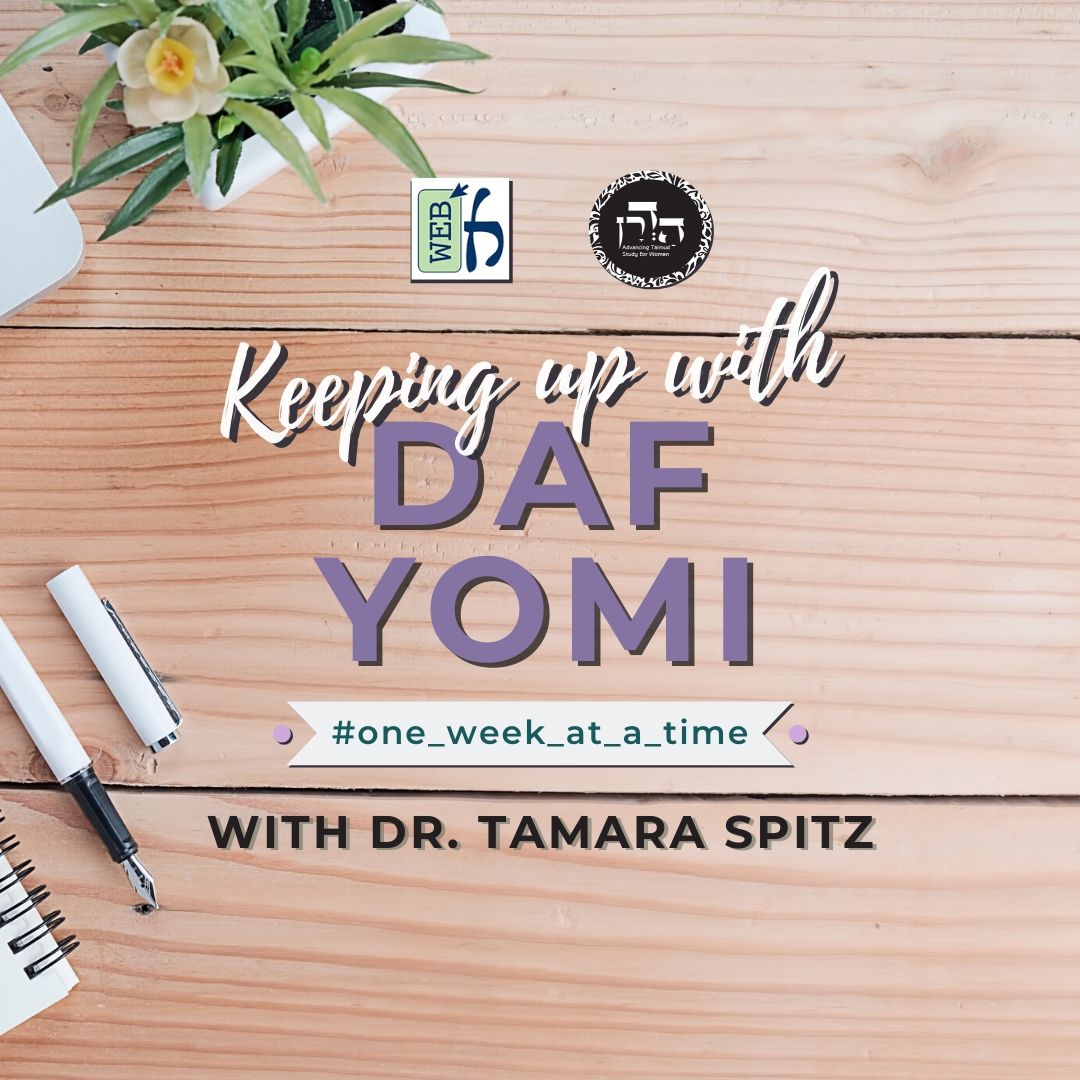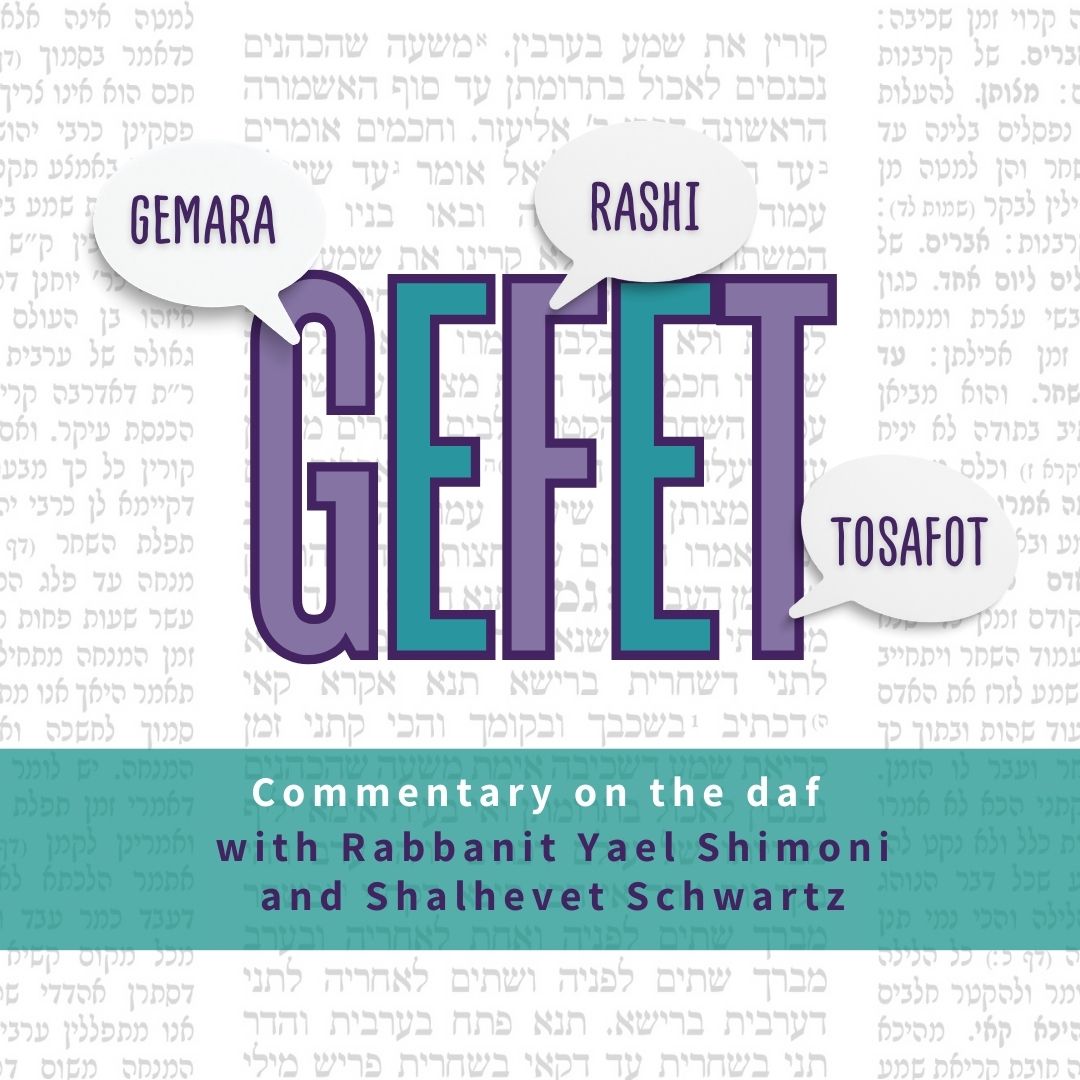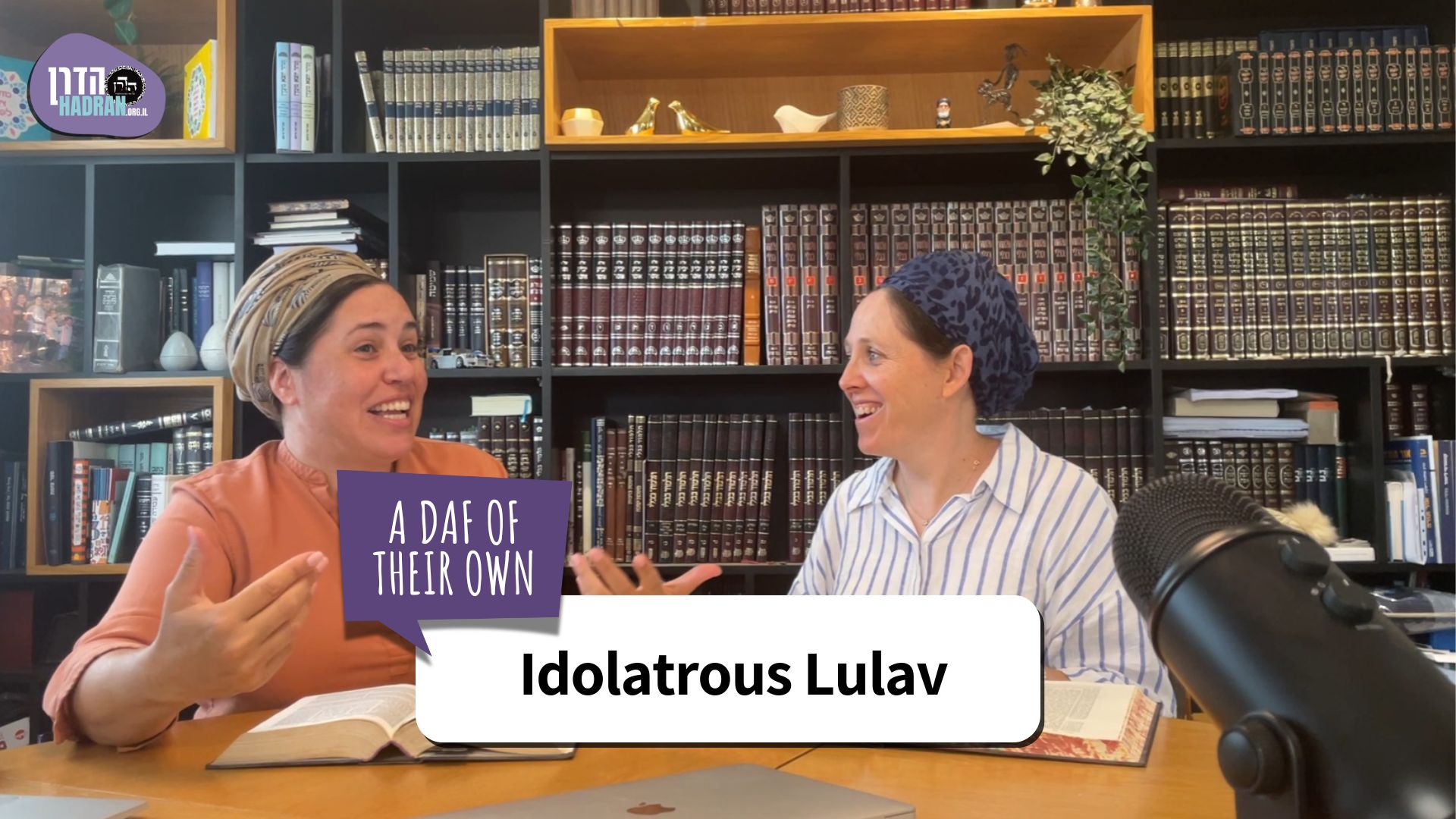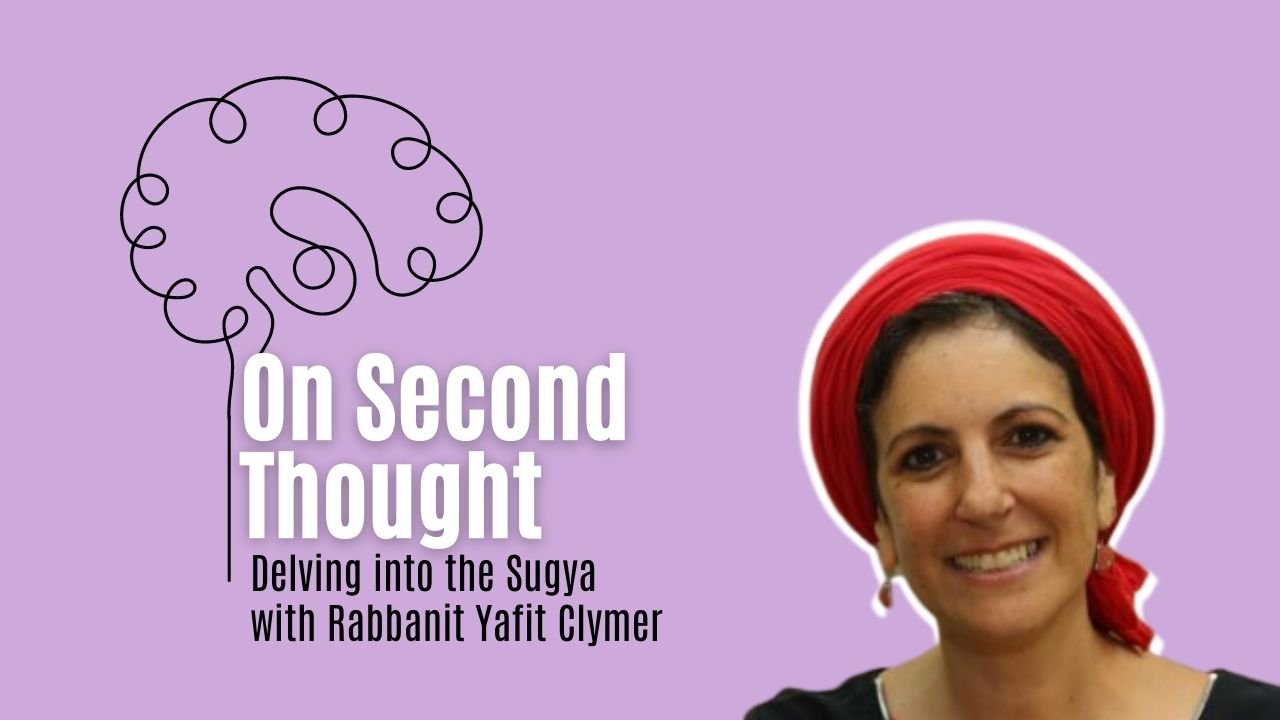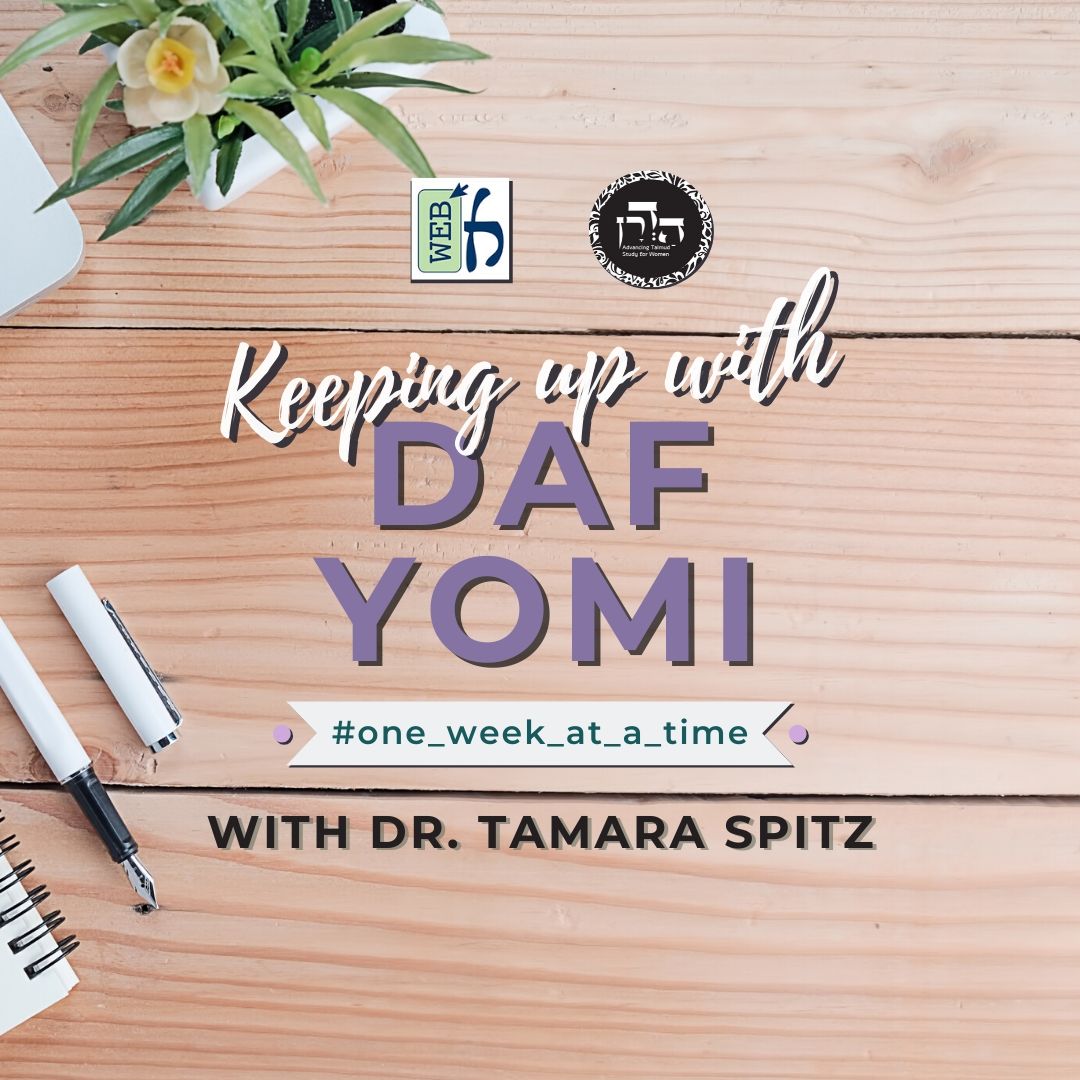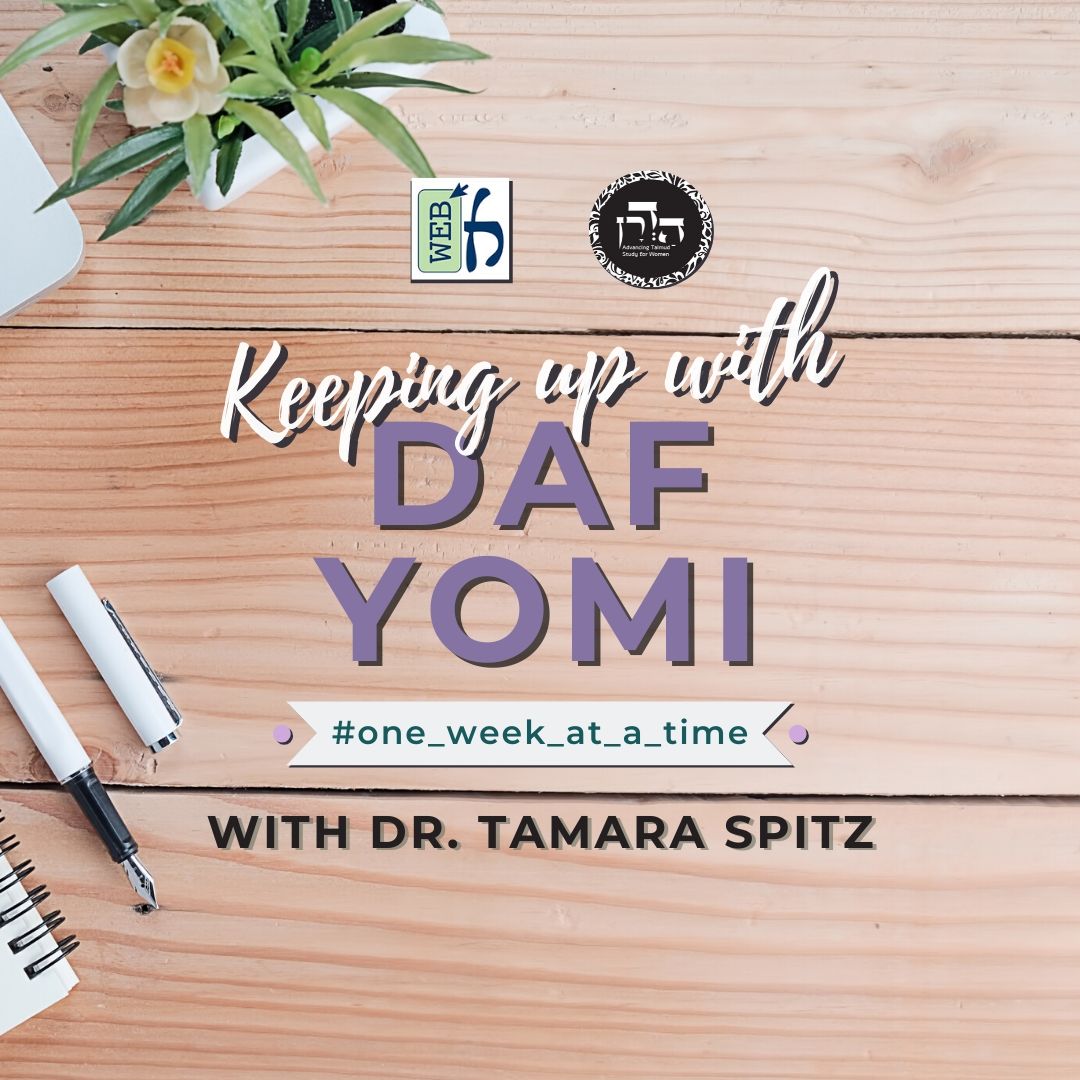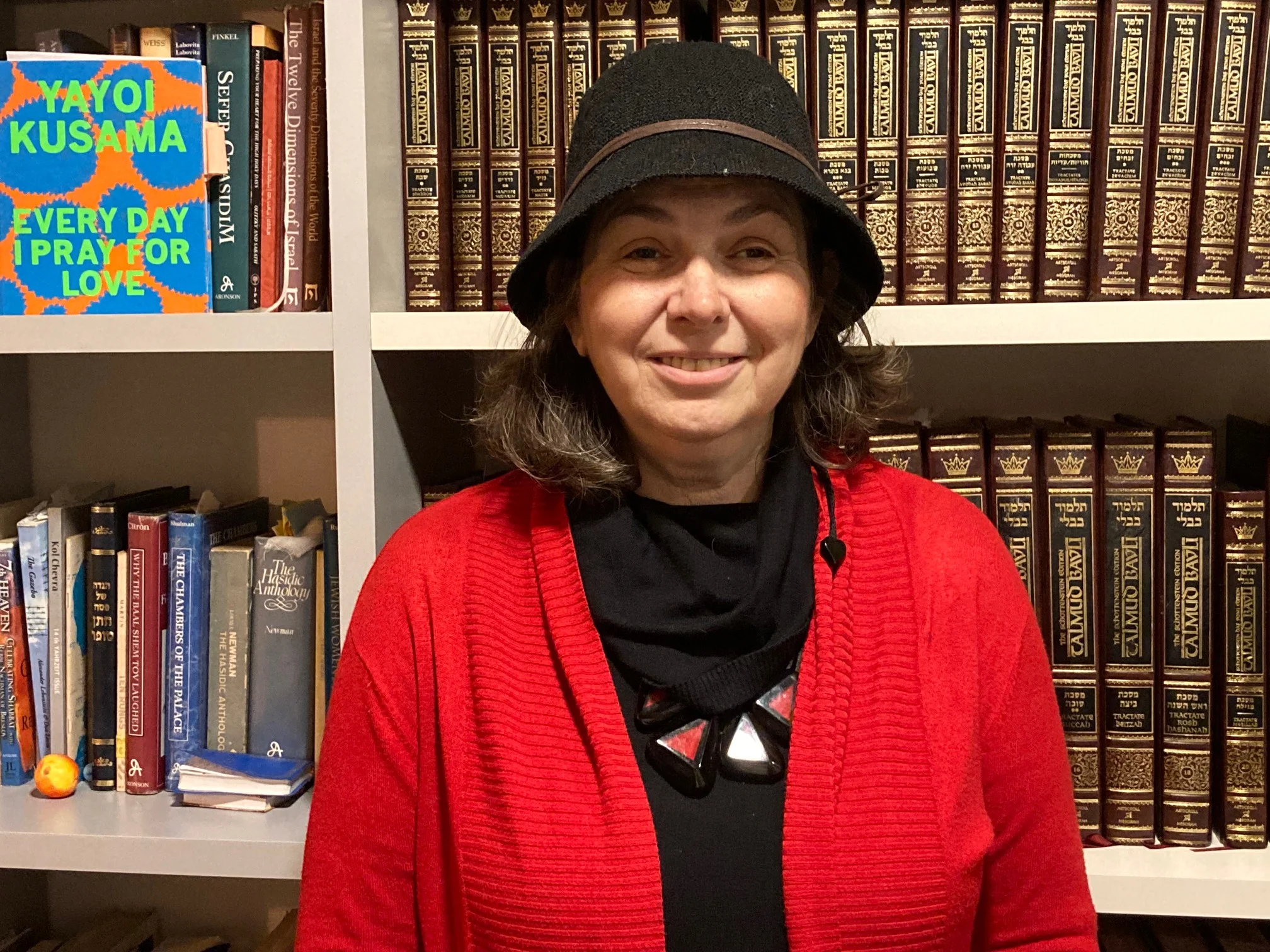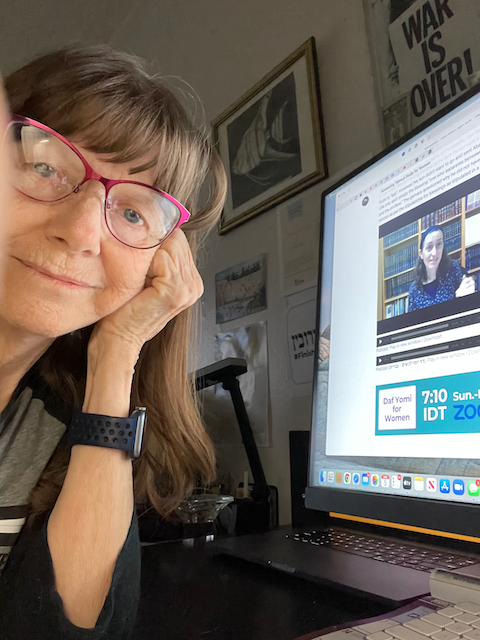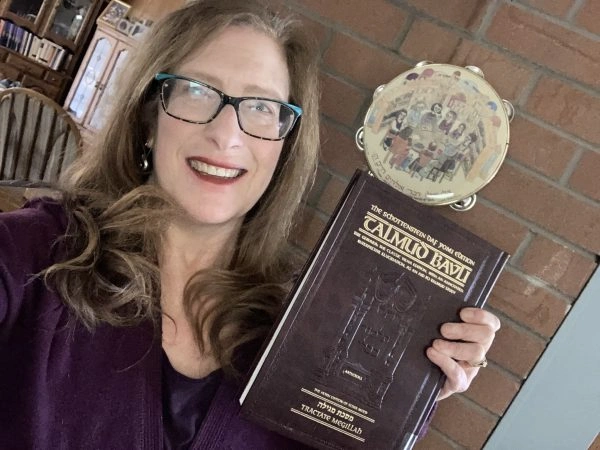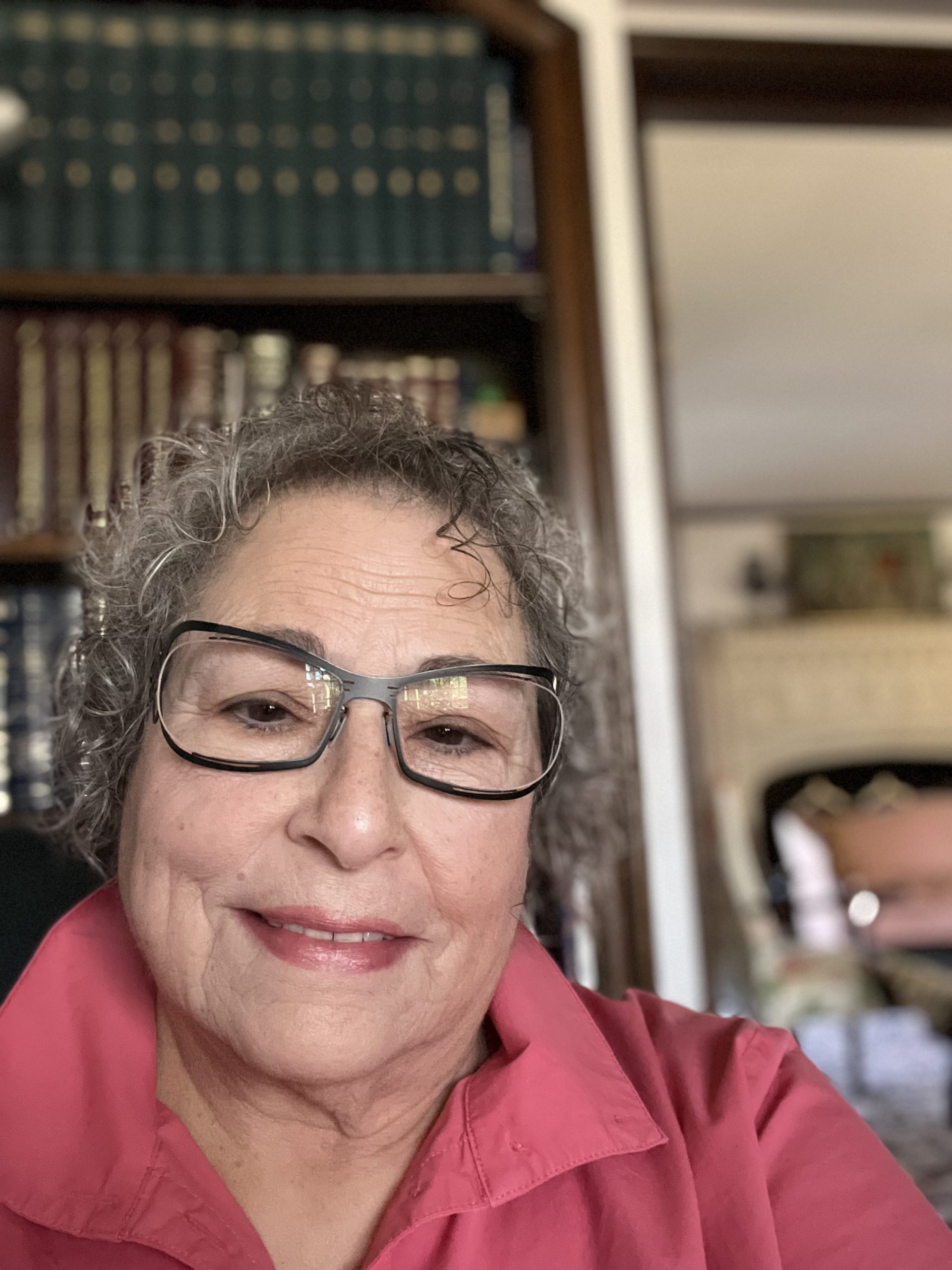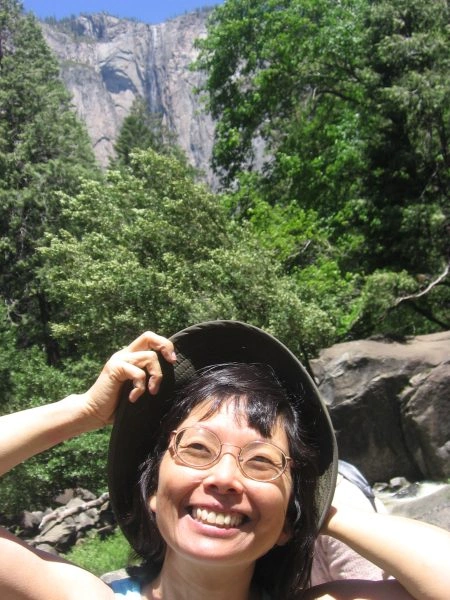This week’s learning is sponsored by Robert and Paula Cohen in loving memory of Joseph Cohen, Yosef ben Moshe HaCohen, z”l. “He was hard working, loved to sing, esp. as a chazan, and was very dedicated to his family and community.”
Want to dedicate learning? Get started here:


Today’s daily daf tools:
This week’s learning is sponsored by Robert and Paula Cohen in loving memory of Joseph Cohen, Yosef ben Moshe HaCohen, z”l. “He was hard working, loved to sing, esp. as a chazan, and was very dedicated to his family and community.”
Today’s daily daf tools:
Delve Deeper
Broaden your understanding of the topics on this daf with classes and podcasts from top women Talmud scholars.
New to Talmud?
Check out our resources designed to help you navigate a page of Talmud – and study at the pace, level and style that fits you.
The Hadran Women’s Tapestry
Meet the diverse women learning Gemara at Hadran and hear their stories.
Menachot 88
אֶת מִי אָבִיא תַּחְתָּיו? אֶלָּא מִדָּה יְתֵירָה שֶׁל לוֹג וּמֶחֱצָה הָיְתָה שָׁם, שֶׁבּוֹ הָיָה מוֹדֵד לַחֲבִיתֵּי כֹּהֵן גָּדוֹל – לוֹג וּמֶחֱצָה בַּבֹּקֶר, לוֹג וּמֶחֱצָה בֵּין הָעַרְבַּיִם.
If so, which size vessel shall I bring in its stead to complete the tally of seven vessels? Rather, there was an additional measuring vessel of one and a half log there in the Temple, with which one would measure the oil used for the griddle-cake offering of the High Priest; one and a half log were used in the morning and one and a half log in the afternoon.
אָמְרוּ לוֹ: חֲצִי לוֹג הָיְתָה שָׁם, וְאֶפְשָׁר לְשַׁעֵר בַּחֲצִי לוֹג.
The Rabbis said to Rabbi Shimon: There is no need for a dedicated vessel for the one and a half log for the High Priest’s offering, as there was a vessel of one-half of a log there, in the Temple, and it is possible to calculate the required one and a half log by using the vessel of one-half of a log three times.
אָמַר לָהֶם: אַף לְדִבְרֵיכֶם, חֲצִי לוֹג וְלוֹג לֹא יַעֲשֶׂה, רְבִיעִית הָיְתָה שָׁם, וְאֶפְשָׁר לְשַׁעֵר בִּרְבִיעִית! אֶלָּא זֶה הַכְּלָל הָיָה בַּמִּקְדָּשׁ: כְּלִי שֶׁמְּשַׁמֵּשׁ מִדָּה זוֹ אֵינוֹ מְשַׁמֵּשׁ מִדָּה אַחֶרֶת.
Rabbi Shimon said to them: But according to your statement as well, one should not fashion a vessel of one-half of a log or of one log, as there was a vessel of one-quarter of a log there, and it is possible to calculate whatever quantity is required by repeatedly using the vessel of one-quarter of a log. Rather, this was the principle with regard to measuring vessels in the Temple: A measuring vessel that was used for measuring this quantity was not used to measure a different quantity.
רַבִּי אֶלְעָזָר בְּרַבִּי צָדוֹק אוֹמֵר: שְׁנָתוֹת הָיוּ בַּהִין וְכוּ׳.
The baraita concludes with an opinion that is also stated in the mishna: Rabbi Elazar, son of Rabbi Tzadok, says: There were graduations on the vessel that held one hin, indicating the respective quantities needed for the bull, the ram, and the lamb.
מַאי אִיכָּא בֵּין רַבִּי מֵאִיר לְרַבִּי יְהוּדָה? אָמַר רַבִּי יוֹחָנָן: בֵּירוּצֵי מִדּוֹת אִיכָּא בֵּינַיְיהוּ.
The Gemara analyzes the baraita. What difference is there between the opinions of Rabbi Meir and Rabbi Yehuda? They both list the same seven vessels, but in a different order. Rabbi Yoḥanan said: The practical difference between them concerns whether the vessels consecrate the overflow [beirutzei] of the measuring vessels, i.e., the liquid that flows down over the outer walls of the vessel when it is filled beyond capacity.
לְמַאן דְּאָמַר מִמַּטָּה לְמַעְלָה, קָסָבַר בֵּירוּצֵי הַמִּדּוֹת נִתְקַדְּשׁוּ, וּרְבִיעִית יָהֵיב לֵיהּ רַחֲמָנָא לְמֹשֶׁה, וְאָמַר לֵיהּ: שַׁעַר דְּקָא עָיְילִי לְהוּ בֵּירוּצִין.
According to the one who said that the vessels should be listed in ascending order of size, i.e., Rabbi Yehuda, he holds that the overflow of measuring vessels is consecrated. His reasoning is as follows: When Moses was commanded to fashion these vessels, the Merciful One initially gave Moses a measuring vessel of one-quarter of a hin and said to him: With this vessel calculate the various quantities needed and fashion vessels accordingly. So, for example, to calculate one-half of a hin, Moses would twice fill up the vessel of one-quarter of a hin, each time pouring it into a larger vessel. When pouring from a small vessel into a larger one, the overflow also enters the larger one and so it is included in the calculation. Evidently, the overflow is also consecrated.
לְמַאן דְּאָמַר מִמַּעְלָה לְמַטָּה, קָסָבַר בֵּירוּצֵי מִדּוֹת לֹא נִתְקַדְּשׁוּ, וְהִין יָהֵיב לֵיהּ רַחֲמָנָא לְמֹשֶׁה, וְאָמַר לֵיהּ: שַׁעַר בְּהָא, דְּקָא נָפְקִי בֵּירוּצִין.
According to the one who said that the vessels should be listed in descending order of size, i.e., Rabbi Meir, he holds that the overflow of measuring vessels is not consecrated. His reasoning is as follows: When Moses was commanded to fashion these vessels for the Temple, the Merciful One initially gave Moses a measuring vessel of one hin and said to him: With this vessel calculate the various quantities needed and fashion vessels accordingly. So, for example, to calculate one-half of a hin, Moses filled the vessel of one hin and divided it equally into two vessels. Then, to calculate one-quarter of a hin, he would equally divide the liquid in one of those vessels into another two vessels. When pouring from a large vessel into a smaller one, the overflow on the outer walls of the larger vessel does not enter the smaller vessel but instead falls to the ground. Therefore, the overflow is excluded from the calculation. Accordingly, there is no basis to say that the overflow is consecrated.
אַבָּיֵי אָמַר: דְּכוּלֵּי עָלְמָא בֵּירוּצֵי הַמִּדּוֹת אִיכָּא לְמֵימַר נִתְקַדְּשׁוּ, וְאִיכָּא לְמֵימַר לֹא נִתְקַדְּשׁוּ, וְהָכָא בִּמְלֵאִים קָא מִיפַּלְגִי.
Abaye said: Everyone, both Rabbi Yehuda and Rabbi Meir, agrees that with regard to the overflow of measuring vessels, one could say that they are consecrated and one could say that they are not consecrated, i.e., their dispute is unrelated to this issue. But here they disagree with regard to the meaning of the term “full” in the verse: “And his offering was one silver dish, its weight was one hundred and thirty shekels, one silver basin of seventy shekels, after the shekel of the Sanctuary; both of them full of fine flour mixed with oil for a meal offering” (Numbers 7:13).
מַאן דְּאָמַר מִלְּמַעְלָה לְמַטָּה, קָא סָבַר מְלֵאִים, שֶׁלֹּא יְחַסֵּר וְשֶׁלֹּא יוֹתִיר.
The one who said that the vessels should be listed in descending order of size, i.e., Rabbi Meir, holds that the term “full” indicates that the size of each vessel should be exact, i.e., that it should hold neither less nor more than the prescribed amount. If one calculates the various sizes by first filling a vessel of the largest size, one hin, and then dividing its contents carefully between two smaller vessels and so on, one will arrive at accurate measurements. By contrast, if one starts with the smallest size and uses it multiple times to calculate larger quantities, then each time one pours he includes the overflow of the smaller vessel, and so the quantities calculated are slightly larger than prescribed.
וּמַאן דְּאָמַר מִמַּטָּה לְמַעְלָה, מְלֵאִים – שֶׁלֹּא יְחַסֵּר, אֲבָל יוֹתִיר, ״מְלֵאִים״ קָרֵינָא בֵּיהּ.
And the one who said that the vessels should be listed in ascending order of size, i.e., Rabbi Yehuda, holds that the intention of the term “full” is that the size of each vessel should not hold less than the prescribed amount, but if it holds more, that is still called full. Accordingly, the various quantities can be calculated by starting with the smallest vessel.
אָמַר מָר: רַבִּי שִׁמְעוֹן אוֹמֵר לֹא הָיָה שָׁם הִין, שַׁפִּיר קָאָמַר לְהוּ רַבִּי שִׁמְעוֹן לְרַבָּנַן! וְרַבָּנַן – הֲוָה הִין דַּעֲבַד מֹשֶׁה לְשֶׁמֶן הַמִּשְׁחָה, דִּכְתִיב ״וְשֶׁמֶן זַיִת הִין״.
In the mishna and the baraita cited above the Master said that in contrast to the opinion of the Rabbis, Rabbi Shimon says: There was no vessel there in the Temple that held one hin, as what purpose could a one-hin vessel serve? That volume of liquid was never used in an offering. The Gemara comments: Rabbi Shimon is saying well to the Rabbis, i.e., this is a reasonable objection. And what would the Rabbis say? Why is there a measuring vessel of one hin? The Gemara answers: It was the vessel of one hin that Moses fashioned in the wilderness for measuring the anointing oil with which the Tabernacle, its vessels, and the priests were anointed, as it is written: “And of olive oil a hin. And you shall make it a holy anointing oil” (Exodus 30:24–25).
מָר סָבַר: כֵּיוָן דִּלְדוֹרוֹת לָא הֲוָה צְרִיךְ, לְפִי שָׁעָה הוּא דְּעַבְדֵיהּ וְאִיגְּנֵז, וְאִידַּךְ: כֵּיוָן דַּהֲוָה – הֲוָה.
The Gemara explains the dispute between Rabbi Shimon and the Rabbis. One Sage, Rabbi Shimon, holds that since there was no further need for the vessel of one hin in future generations, Moses fashioned it only for the sake of that time, and then afterward it was sequestered. And the other Sage, the Rabbis, holds that since it was fashioned and used in the time of Moses, it was kept in the Temple despite the fact there was no longer a need for it.
אָמַר מָר: וְאֶת מִי אָבִיא תַּחְתָּיו. לָא סַגִּיא דְּלָא מְעַיֵּיל? כִּדְאָמַר רָבִינָא: גְּמִירִי שְׁתֵּי סְמִיכוֹת בְּצִיבּוּר, הָכָא נָמֵי גְּמִירִי דְּשֶׁבַע מִדּוֹת שֶׁל לַח הָיוּ בְּמִקְדָּשׁ.
The Master said in the baraita that after claiming that there was no vessel of one hin, Rabbi Shimon asked: If so, which size vessel shall I bring in its stead to complete the tally of seven vessels? The Gemara asks: Is it not possible to simply not include a seventh vessel? What compels him to list a seventh? The Gemara explains: It is just as Ravina said with regard to a different matter: It is learned as a tradition that there are two instances in which placing hands on the head of the offering is required for communal offerings. Here too, one must say that it is learned as a tradition that there were seven measuring vessels for liquids in the Temple.
רַבִּי אֶלְעָזָר בְּרַבִּי צָדוֹק אוֹמֵר: שְׁנָתוֹת הָיוּ בַּהִין. וְלֵית לֵיהּ שֶׁבַע מִדּוֹת? לֵית לֵיהּ. וְאִי בָּעֵית אֵימָא: מַאי ״שֶׁבַע מִדּוֹת״? שֶׁבַע מְדִידוֹת.
The mishna teaches: Rabbi Elazar, son of Rabbi Tzadok, says: It was not necessary to have separate vessels for the meal offerings and libations of each type of animal. Rather, there were graduations on the vessel that held one hin indicating the measures for the various offerings. The Gemara asks: But doesn’t Rabbi Eliezer, son of Rabbi Tzadok, have the tradition that there were seven measuring vessels? The Gemara concedes: He does not have that tradition. And if you wish, say instead that he has that tradition, but he understands that what is meant by seven measuring vessels? It means that seven fixed ways of measuring should exist, but not that there must be seven different vessels.
מַתְנִי׳ רְבִיעִית מָה הָיְתָה מְשַׁמֶּשֶׁת? רְבִיעִית מַיִם לִמְצוֹרָע, וּרְבִיעִית שֶׁמֶן לְנָזִיר.
MISHNA: What purpose did the quarter-log measuring vessel serve? It was used to measure a quarter-log of water for the purification of the leper, and a quarter-log of oil for the wafers and loaves that the nazirite brings on the day that his term of naziriteship ends.
חֲצִי לוֹג מָה הָיָה מְשַׁמֵּשׁ? חֲצִי לוֹג מַיִם לְסוֹטָה, וַחֲצִי לוֹג שֶׁמֶן לְתוֹדָה.
What purpose did the half–log measuring vessel serve? It was used to measure a half-log of water for the rite of the sota and a half-log of oil for the three types of loaves of matza accompanying the thanks offering.
וּבַלּוֹג הָיָה מוֹדֵד לְכׇל הַמְּנָחוֹת.
And with the vessel of one log, one would measure the oil for all the standard meal offerings.
אֲפִילּוּ מִנְחָה שֶׁל שִׁשִּׁים עִשָּׂרוֹן, נוֹתֵן לָהּ שִׁשִּׁים לוֹג. רַבִּי אֱלִיעֶזֶר בֶּן יַעֲקֹב אוֹמֵר: אֲפִילּוּ מִנְחָה שֶׁל שִׁשִּׁים עִשָּׂרוֹן אֵין לָהּ אֶלָּא לוּגָּהּ, שֶׁנֶּאֱמַר ״לְמִנְחָה וְלֹג שָׁמֶן״.
Each tenth of an ephah of flour requires one log of oil. Accordingly, even if one brings a meal offering of sixty tenths of an ephah of flour, one adds to it sixty log of oil. Rabbi Eliezer ben Ya’akov says: Each meal offering, irrespective of its volume, even a meal offering of sixty tenths of an ephah of flour, requires only its single log of oil, as it is stated with regard to the offering brought by a poor leper on the day of his purification: “And a tenth of an ephah of fine flour mixed with oil for a meal offering, and a log of oil” (Leviticus 14:21). The juxtaposition of “a meal offering” with “a log of oil” teaches a principle for all meal offerings: Each offering requires only one log of oil.
שִׁשָּׁה לַפָּר, וְאַרְבָּעָה לָאַיִל, וּשְׁלֹשָׁה לַכֶּבֶשׂ.
The mishna lists the quantities of oil and wine that were required for the meal offerings and libations that accompanied the sacrifice of an animal. Six log, i.e., one–half of a hin, for those of a bull; and four log, i.e., one-third of a hin, for those of a ram; and three log, i.e., one-quarter of a hin, for those of a lamb.
שְׁלֹשָׁה וּמֶחֱצָה לַמְּנוֹרָה, חֲצִי לוֹג לְכׇל נֵר.
In addition, three and a half log of oil were required for the Candelabrum, as there were seven lamps and a half-log was required for each lamp.
גְּמָ׳ יְתֵיב רַבִּי וְקָא קַשְׁיָא לֵיהּ: רְבִיעִית לָמָּה נִמְשְׁחָה? אִי מְצוֹרָע –
GEMARA: Rabbi Yehuda HaNasi was sitting in study and posed a difficulty: For what purpose was the quarter-log measuring vessel anointed with the anointing oil, thereby consecrating it a service vessel? If you suggest it was necessary in order to measure the water used in the purification of a leper,
חוּץ הוּא, וְאִי נָזִיר – לֶחֶם נָזִיר בִּשְׁחִיטַת אַיִל הוּא דְּקָדֵישׁ.
one can counter that the rite is performed outside the Temple, and so it does not require a service vessel. And if you suggest it was for measuring the oil for the loaves of a nazirite, one can counter that the loaves of a nazirite are consecrated through the slaughter of the ram he brings, and there is no need for the oil to have been consecrated through a service vessel.
אֲמַר לֵיהּ רַבִּי חִיָּיא: שֶׁבָּהּ הָיָה מוֹדֵד לַחֲבִיתֵּי כֹּהֵן גָּדוֹל, רְבִיעִית שֶׁמֶן לְכׇל חַלָּה וְחַלָּה. קָרֵי עֲלֵיהּ ״מֵאֶרֶץ מֶרְחָק אִישׁ עֲצָתִי״.
Rabbi Ḥiyya said to Rabbi Yehuda HaNasi: The consecration of the quarter-log measuring vessel was necessary, as with it one would measure oil for the High Priest’s griddle-cake offering, as a quarter–log of oil is used for each and every loaf. In praise for resolving his difficulty, Rabbi Yehuda HaNasi read the verse about Rabbi Ḥiyya, who had traveled from Babylonia to join Rabbi Yehuda HaNasi in Eretz Yisrael: “The man of my counsel from a far country” (Isaiah 46:11).
חֲצִי לוֹג, מָה הָיָה מְשַׁמֵּשׁ? יְתֵיב רַבִּי וְקָא קַשְׁיָא לֵיהּ: חֲצִי לוֹג לָמָּה נִמְשַׁח? אִי סוֹטָה – וְכִי חוּלִּין הוּא דִּצְרִיכִי לְקַדּוֹשֵׁי? ״מַיִם קְדוֹשִׁים״ כְּתִיב! אִי תּוֹדָה – לַחְמֵי תוֹדָה בִּשְׁחִיטַת תּוֹדָה הוּא דְּקָדְשִׁי.
§ The mishna teaches: What purpose did the half-log measuring vessel serve? It was used to measure a half-log of water for the sota and a half-log of oil for the thanks offering. The Gemara relates: Rabbi Yehuda HaNasi was sitting in study and posed a difficulty: For what purpose was the half-log measuring vessel anointed with the anointing oil, thereby consecrating it a service vessel? If you suggest it was necessary in order to measure the water used in the rite of the sota, one can counter: Is the water that was used non-sacred such that it is necessary to consecrate it? Isn’t it written: “And the priest shall take holy water in an earthen vessel” (Numbers 5:17)? And if you suggest that it was for measuring the oil for the loaves of a thanks offering, one can counter that the loaves of a thanks offering are consecrated through the slaughter of the thanks offering, and so there is no need for the oil to have been consecrated through a service vessel.
אֲמַר לֵיהּ רַבִּי שִׁמְעוֹן בְּרַבִּי: שֶׁבּוֹ הָיָה מְחַלֵּק חֲצִי לוֹג שֶׁמֶן לְכׇל נֵר וָנֵר. אָמַר לוֹ: נֵר יִשְׂרָאֵל, כָּךְ הָיָה.
Rabbi Shimon, son of Rabbi Yehuda HaNasi, said to his father: The consecration of the half-log measuring vessel was necessary, as with it one would distribute a half-log of oil to each and every lamp of the Candelabrum. Rabbi Yehuda HaNasi said to his son in praise: Lamp of Israel! Indeed, that was its use.
אָמַר רַבִּי יוֹחָנָן אָמַר רַבִּי: נֵר שֶׁכָּבְתָה, נִידַּשֵּׁן הַשֶּׁמֶן, נִידַּשְּׁנָה הַפְּתִילָה. כֵּיצַד עוֹשֶׂה? מְטִיבָהּ, וְנוֹתֵן בָּהּ שֶׁמֶן, וּמַדְלִיקָהּ.
§ Apropos the lamps of the Candelabrum, the Gemara relates that Rabbi Yoḥanan says that Rabbi Yehuda HaNasi says: If there is a lamp whose flame went out during the night, the oil in the lamp is halakhically rendered as ashes and the wick is rendered as ashes, and they may no longer be used. How should the priest act? He removes the ashes, i.e., the oil and wick, from the lamp, and puts new oil and a new wick into it and kindles it.
יָתֵיב רַבִּי זְרִיקָא, וְקָא מִיבַּעְיָא לֵיהּ: כְּשֶׁהוּא נוֹתֵן בָּהּ שֶׁמֶן – כְּמִדָּה רִאשׁוֹנָה, אוֹ כְּמוֹ שֶׁחָסְרָה?
Rav Zerika was sitting and studying this halakha and raised a dilemma: When the priest puts oil in the lamp, does he fill it with the same quantity of oil that was initially used, i.e., a half-log, or does he just fill it with an amount equal to what it now lacks, in order to replace the oil that was removed?
אָמַר רַבִּי יִרְמְיָה: פְּשִׁיטָא דִּכְמִדָּה רִאשׁוֹנָה, דְּאִי כְּמָה שֶׁחָסְרָה – מְנָא יָדְעִינַן מַאי חִיסֵּר? וְכִי תֵּימָא דִּמְשַׁעַר לֵיהּ, אִם כֵּן שֶׁבַע מִדּוֹת (נפיש) [נְפִישִׁי] לְהוּ מִדּוֹת טוּבָא.
Rabbi Yirmeya said: It is obvious that he fills it with the same quantity of oil that was initially used, as, if he were to fill with an amount equal to what it now lacks, there would be a difficulty: How do we know how much oil it lacks? And if you would say that the priest calculates it using a measuring vessel, one could counter that if so, there would not be only seven measuring vessels for liquids; rather, there would have to be many more measuring vessels of a whole range of volumes.
קָרֵי עֲלֵיהּ: ״וַהֲדָרְךָ צְלַח רְכַב עַל דְּבַר אֱמֶת וְעַנְוָה צֶדֶק״.
In praise for resolving his difficulty, Rabbi Zerika read the verse about Rabbi Yirmeya: “And in your majesty prosper, ride on, on behalf of truth and meekness and righteousness” (Psalms 45:5).
אִיתְּמַר נָמֵי, אָמַר רַבִּי אֲבָהוּ אָמַר רַבִּי יוֹחָנָן, וְאָמְרִי לַהּ אָמַר רַבִּי אַבָּא אָמַר רַבִּי חֲנִינָא אָמַר רַבִּי: נֵר שֶׁכָּבְתָה, נִידַּשֵּׁן הַשֶּׁמֶן נִידַּשְּׁנָה הַפְּתִילָה. כֵּיצַד עוֹשֶׂה? מְטִיבָהּ, וְנוֹתֵן בָּהּ שֶׁמֶן כְּמִדָּה רִאשׁוֹנָה, וּמַדְלִיקָהּ.
An amoraic ruling was also stated in accordance with the explanation of Rabbi Yirmeya: Rabbi Abbahu says that Rabbi Yoḥanan says, and some say that Rabbi Abba says that Rabbi Ḥanina says that Rabbi Yehuda HaNasi says: If there is a lamp whose flame went out during the night, the oil in the lamp is rendered as ashes and the wick is rendered as ashes, and they may no longer be used. How should the priest act? He removes the ashes, i.e., the oil and wick, from the lamp, and puts into it oil of the same quantity that was initially used, with a new wick, and kindles it.
אָמַר רַב הוּנָא בְּרֵיהּ דְּרַב יְהוּדָה, אָמַר רַב שֵׁשֶׁת: נֵר שֶׁבְּמִקְדָּשׁ שֶׁל פְּרָקִים הֲוָה.
§ Rav Huna, son of Rav Yehuda, says that Rav Sheshet says: Each lamp of the Candelabrum in the Temple was movable, as the branches holding it were thin and flexible. They could therefore be bent over in order to tip out any ashes, remaining oil, or wicks from the lamps. The basis for his opinion is the verse: “And you shall make a Candelabrum of pure gold, of beaten work the Candelabrum shall be made, its base, and its shaft; its cups, its knobs, and its flowers, will be from it…of a talent of pure gold it shall be made” (Exodus 25:31, 39).
קָסָבַר: כִּי כְּתִיב ״כִּכָּר״ וּ״מִקְשָׁה״ – אַמְּנוֹרָה וְנֵרוֹתֶיהָ כְּתִיב, כֵּיוָן דְּמִיבַּעְיָא הֲטָבָה, אִי לָאו דִּפְרָקִים הֲוַי – לָא הֲוָה מִטַּיְּיבָא לֵיהּ.
The Gemara explains that Rav Sheshet holds that when it is written that the Candelabrum is to be fashioned from a single talent of gold, and that it be beaten into its form, it is written with regard to both the frame of Candelabrum and each of its lamps, i.e., they must all be fashioned together from a single piece of gold beaten into its form. Perforce, the lamps must have been movable, because since it is necessary to remove the ashes from the lamps, were each lamp not movable, it would not be possible to remove the ashes.
מֵיתִיבִי: כֵּיצַד עוֹשֶׂה? מְסַלְּקָן, וּמַנִּיחָן בְּאוֹהֶל, וּמְקַנְּחָן בִּסְפוֹג, וְנוֹתֵן בָּהֶן שֶׁמֶן, וּמַדְלִיקָן.
The Gemara raises an objection to Rav Sheshet’s opinion from a baraita: How would the priest act when removing the ashes from the lamps? He would remove the lamps from the Candelabrum and place them in the Tent of Meeting, i.e., the Sanctuary, and scrub them with a sponge [bisfog] to remove any remaining oil. And then he would put fresh oil into them and kindle them. Evidently, the lamps and the frame of the Candelabrum were separate parts.
הוּא דְּאָמַר כִּי הַאי תַּנָּא, דְּתַנְיָא: חֲכָמִים אוֹמְרִים: לֹא הָיוּ מִזִּיזִין אוֹתָהּ מִמְּקוֹמָהּ.
The Gemara explains that there is a dispute between tanna’im concerning this issue and Rav Sheshet states his opinion in accordance with the opinion of that tanna, as it is taught in a baraita: The Rabbis say that when removing the ashes, the priest would not move the lamp from its place; rather, he would remove the ashes while the lamp was still attached to the frame.
מִכְּלָל דְּאִי בָּעֵי (לֵיהּ) לְאוֹזוֹזַהּ מָצֵי מֵזֵיז לַהּ? אֶלָּא אֵימָא: לֹא הָיְתָה זָזָה מִמְּקוֹמָהּ.
The Gemara raises a difficulty: But from the fact that the baraita states that the priest would not move the lamp from its place, it would appear that if one wanted to move it, he was able to move it from its place. Apparently, then, the lamps were independent parts. The Gemara explains: Rather, emend the baraita to say: The lamp would not move from its place, as the lamps were not independent removable parts but were formed together with the frame from a single piece of gold.
וּמַאן חֲכָמִים? רַבִּי אֶלְעָזָר הוּא, דְּתַנְיָא: רַבִּי אֶלְעָזָר בְּרַבִּי צָדוֹק אוֹמֵר: כְּמִין טַס שֶׁל זָהָב הָיָה לָהּ עַל גַּבָּהּ, כְּשֶׁהוּא מְטִיבָהּ – דּוֹחֲקוֹ כְּלַפֵּי פִּיהָ, כְּשֶׁהוּא נוֹתֵן בָּהּ שֶׁמֶן – דּוֹחֲקוֹ כְּלַפֵּי רֹאשָׁהּ.
The Gemara asks: And whose opinion is expressed by the Rabbis in the baraita? It is the opinion of Rabbi Elazar, as it is taught in another baraita: Rabbi Elazar, son of Rabbi Tzadok, says: There was a kind of gold plate [tas] for each lamp, which was placed on top of it and which served as a cover for the lamp. The plate was attached to one side of the lamp, to the lamp’s head, and the wick emerged from the other side, from the lamp’s mouth. When the priest would come to remove the ashes from the lamp, he would first push up on the part of the plate at the mouth of the lamp, thereby exposing its contents. The lamp would then be bent over and its contents tipped out. And when he would come to place fresh oil and a wick in the lamp, he would place the new wick at its mouth and then push down on the plate at the head of the lamp, thereby closing it, then he would straighten it up and pour in the oil through a hole in the middle of the plate.
וּבִפְלוּגְתָּא דְּהָנֵי תַּנָּאֵי, דְּתַנְיָא: מְנוֹרָה וְנֵרוֹתֶיהָ בָּאוֹת מִן הַכִּכָּר, וְאֵין מַלְקָחֶיהָ וּמַחְתּוֹתֶיהָ מִן הַכִּכָּר. רַבִּי נְחֶמְיָה אוֹמֵר: מְנוֹרָה הָיְתָה בָּאָה מִן הַכִּכָּר, וְלֹא נֵרוֹתֶיהָ וּמַלְקָחֶיהָ וּמַחְתּוֹתֶיהָ בָּאוֹת מִן הַכִּכָּר.
The Gemara comments: And whether or not the lamps were independent removable parts is the subject of a dispute between these following tanna’im, as it is taught in a baraita: Both the frame of the Candelabrum and its lamps are produced together from the same talent of gold. But its tongs and its pans, which were the implements used for removing the ashes, were not fashioned from that same gold talent. Rabbi Neḥemya says: Only the frame of the Candelabrum is produced from the talent of gold, but its lamps and its tongs and its pans are not produced from that same gold talent; rather, they are formed independently. The lamps are then positioned on the frame, but can still be removed from it.
בְּמַאי קָא מִיפַּלְגִי? בְּהַאי קְרָא, דְּתַנְיָא: ״כִּכָּר זָהָב טָהוֹר יַעֲשֶׂה אֹתָהּ״ – לָמַדְנוּ לַמְּנוֹרָה שֶׁבָּאָה מִן הַכִּכָּר, מִנַּיִן לְרַבּוֹת נֵרוֹתֶיהָ? תַּלְמוּד לוֹמַר: ״אֶת כׇּל הַכֵּלִים הָאֵלֶּה״. יָכוֹל שֶׁאֲנִי מְרַבֶּה אַף מַלְקָחֶיהָ וּמַחְתּוֹתֶיהָ? תַּלְמוּד לוֹמַר: ״אֹתָהּ״, דִּבְרֵי רַבִּי נְחֶמְיָה.
The Gemara asks: With regard to what do these tanna’im disagree? The Gemara explains: They disagree with regard to the exposition of this verse, as it is taught in a baraita: From the verse: “Of a talent of pure gold it shall be fashioned with all these vessels” (Exodus 25:39), we learned about the frame of the Candelabrum that it is produced from the gold talent. From where is it derived to include its lamps, that they should also be fashioned together with the frame from the same talent? The verse states: “It shall be fashioned with all these vessels.” This indicates that not only the frame, but also additional parts should be fashioned from the same talent. If so, one might have thought that I should include even its tongs and its pans. To counter this, the verse states: “It shall be fashioned.” The additional word “it” teaches that only the frame and the lamps are to be fashioned from the gold talent. This is the statement of Rabbi Neḥemya.
קַשְׁיָא דְּרַבִּי נְחֶמְיָה אַדְּרַבִּי נְחֶמְיָה, תְּרֵי תַּנָּאֵי וְאַלִּיבָּא דְּרַבִּי נְחֶמְיָה.
The Gemara interrupts the citation of the baraita and notes that the statement of Rabbi Neḥemya in this baraita, in which he claims the lamps were fashioned from the talent with the frame, is difficult, as it is contradicted by the statement of Rabbi Neḥemya in the other baraita, in which he claims the lamps were independent parts. The Gemara explains: There are two tanna’im, and they disagree with regard to the opinion of Rabbi Neḥemya.
רַבִּי יְהוֹשֻׁעַ בֶּן קׇרְחָה אוֹמֵר: מְנוֹרָה בָּאָה מִן הַכִּכָּר, וְאֵין מַלְקָחֶיהָ וּמַחְתּוֹתֶיהָ וְנֵרוֹתֶיהָ בָּאָה מִן הַכִּכָּר. וְאֶלָּא מָה אֲנִי מְקַיֵּים אֵת ״כׇּל הַכֵּלִים הָאֵלֶּה״ – שֶׁהָיוּ כֵּלִים שֶׁל זָהָב.
The Gemara resumes its citation of the baraita: Rabbi Yehoshua ben Korḥa says: Only the frame of the Candelabrum was produced from the talent of gold, but its tongs and its pans and its lamps were not produced from the talent. Rather, how do I realize the meaning of the verse: “Of a talent of pure gold it shall be fashioned with all these vessels”? It teaches only that all the vessels associated with the Candelabrum were made of gold, even though they were not fashioned from the same gold talent from which the Candelabrum and its lamps were.
זָהָב בְּהֶדְיָא כְּתִיב בּוֹ, ״וְעָשִׂיתָ אֶת נֵרֹתֶיהָ שִׁבְעָה וְהֶעֱלָה אֶת נֵרֹתֶיהָ וְהֵאִיר אֶל עֵבֶר פָּנֶיהָ. וּמַלְקָחֶיהָ וּמַחְתֹּתֶיהָ זָהָב טָהוֹר״. לֹא נִצְרְכָא אֶלָּא לְפִי נֵרוֹת, סָלְקָא דַּעְתָּךְ אָמֵינָא: הוֹאִיל וּפִי נֵרוֹת אַשְׁחוֹרֵי מַשְׁחַר, הַתּוֹרָה חָסָה עַל מָמוֹנָן שֶׁל יִשְׂרָאֵל,
The Gemara questions the need for the derivation of the baraita: But the requirement that the vessels be made of gold is explicitly written in the verse: “And you shall fashion its lamps seven, and they shall kindle its lamps, and it will enlighten toward its face. And its tongs and its pans shall be of pure gold” (Exodus 25:37–38); why then is it necessary for the baraita to derive this from the phrase “with all these vessels”? The Gemara explains: This derivation of the baraita is necessary only to teach that the same applies to the mouth of the lamps, where the wicks rest. Otherwise, it might enter your mind to say that since the mouth of the lamps blackens and is damaged by the burning wick, therefore the principle that the Torah spared the money of the Jewish people should be applied,



